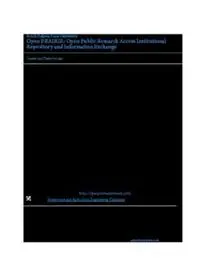Table Of ContentSouth Dakota State University
Open PRIRIE: Open Public Research Access Institutional
Repository and Information Exchange
Teses and Dissertations
2016
Behavior of Light in a Photobioreactor and Design
of Light Guides
Anand Rajendran
South Dakota State University
Follow this and additional works at: htp://openprairie.sdstate.edu/etd
Part of the Bioresource and Agricultural Engineering Commons
Recommended Citation
Rajendran, Anand, "Behavior of Light in a Photobioreactor and Design of Light Guides" (2016).Teses and Dissertations. Paper 985.
Tis Tesis - Open Access is brought to you for free and open access by Open PRIRIE: Open Public Research Access Institutional Repository and
Information Exchange. It has been accepted for inclusion in Teses and Dissertations by an authorized administrator of Open PRIRIE: Open Public
Research Access Institutional Repository and Information Exchange. For more information, please contact
BEHAVIOR OF LIGHT IN A PHOTOBIOREACTOR AND
DESIGN OF LIGHT GUIDES
BY
ANAND RAJENDRAN
A thesis submitted in partial fulfillment of the requirements for the
Master of Science
Major in Agricultural and Biosystems Engineering
South Dakota State University
2016
iii
I would like to dedicate this thesis work to my parents and friends.
iv
ACKNOWLEDGEMENTS
I would like to acknowledge my advisor and mentor Dr. Gary Anderson, for his constant
support in accomplishing the research work.
I would like to thank my committee members, Dr. Larry Browning, Dr. Zhengrong Gu,
and Dr. Renee Oscarson for their valuable suggestions, time and support whenever I
required it.
Finally, I want to thank my parents, my wife, friends and family for their continuous
support in achieving what I am today.
v
CONTENTS
ABBREVIATIONS.......................................................................................................... viii
LIST OF FIGURES ........................................................................................................... ix
LIST OF TABLES ........................................................................................................... xiii
ABSTRACT ..................................................................................................................... xiv
1. INTRODUCTION ...........................................................................................................1
2. LITERATURE REVIEW ................................................................................................7
2.1. Photo-autotrophic microorganisms ..........................................................................7
2.2. Mass production of microalgae ................................................................................7
2.3. Photobioreactors .......................................................................................................7
2.4. Mixing of biomass and nutrient medium .................................................................9
2.5. Extinction coefficient .............................................................................................10
2.6. Nature of light ........................................................................................................11
2.6.1. Photosynthetic active radiation (PAR).........................................................12
2.7. Photosynthesis ........................................................................................................13
2.7.1 Light reactions ..............................................................................................13
2.7.2 Dark reactions ...............................................................................................15
2.8. Photosynthesis-Irradiance curve.............................................................................15
2.8.1 Light compensation point .............................................................................15
2.9. Effect of light on the microalgal cells ....................................................................18
2.10. Light sources ........................................................................................................18
2.11. Light attenuation...................................................................................................19
2.12. Light –dark cycles ................................................................................................20
2.13. Theory of light guides ..........................................................................................20
2.13.1. Ray tracing analysis ...................................................................................21
2.13.2. Total internal reflection ..............................................................................22
2.13.3. Acceptance angle .......................................................................................24
2.13.4. Ray propagation in a light guide ................................................................25
vi
2.13.5. Analysis of light guides .............................................................................26
3. MATERIALS AND METHODS ...................................................................................28
3.1. Extinction coefficient test .......................................................................................28
3.1.1. Materials used ..............................................................................................28
3.1.2. Test Procedure .............................................................................................31
3.1.2.1. Phase 1: Light interaction with gas bubbles ....................................32
3.1.2.2. Phase 2: Light attenuation with distance .........................................32
3.1.2.3. Phase 3: Light interaction with suspended biomass and dissolved
nutrients ........................................................................................................33
3.2. Light guide test .......................................................................................................33
3.2.1. Materials used ..............................................................................................34
3.2.1.1 Types of light guide ..........................................................................37
3.2.1.2. Design factors ..................................................................................39
3.2.1.2.1. Primary design factors ........................................................39
3.2.1.2.2. Secondary design factor .....................................................42
3.2.2. Test Procedure .............................................................................................43
4. RESULT AND DISCUSSIONS ....................................................................................47
4.1. Extinction coefficient .............................................................................................47
4.1.1. Phase 1: Light attenuation with pathlength ..................................................49
4.1.2. Phase 2: Interaction of light with gas bubbles .............................................51
4.1.3. Phase 3: Interaction of light with biomass concentration ............................54
4.2. Light guide test .......................................................................................................56
4.2.1. Effect of change in diameters of light guides ..............................................57
4.2.2. Effect of change in lengths of light guides ..................................................58
4.2.3. Effects of change in exit surface angles of light guides ...............................58
4.2.3.1. Light guide with 90° flat exit end ....................................................58
4.2.3.2. Light guide with 30° tapered exit end ..............................................59
4.2.3.3. Light guide with 60° tapered exit end ..............................................60
4.2.4. Photon transmission efficiency of light guides ...................................................61
vii
4.2.4.1. Case 1: Simple light guides .............................................................61
4.2.4.2. Case 2: Compound light guides .......................................................68
4.2.4.3. Type 1: Two-sectioned light guide ..................................................68
4.2.4.3.1. Sequence type-I: Light guides with sectional diameters
(50.8 mm & 25.4 mm) .....................................................................69
4.2.4.3.2. Sequence type-2: Light guides with sectional diameters
(25.4 mm & 9.53 mm) .....................................................................72
4.2.4.4. Type 2: Three-section light guides ..................................................74
5. CONCLUSIONS............................................................................................................78
FUTURE WORK ...............................................................................................................81
REFERENCES ..................................................................................................................82
APPENDIX - A..................................................................................................................85
APPENDIX - B ..................................................................................................................86
APPENDIX - C ..................................................................................................................87
APPENDIX - D..................................................................................................................88
APPENDIX - E ..................................................................................................................91
viii
ABBREVIATIONS
PBR Photobioreactor
PAR Photosynthetic active radiation
ATP Adenosine triphosphate
ADP Adenosine diphosphate
NADHP Nicotinamide adenine dinucleotide phosphate (reduced form)
LHC Light harvesting chlorophyll
TIR Total internal reflection
-2 -1
PPFD Photosynthetic photon flux density, µmol m s
ix
LIST OF FIGURES
Figure 1.1. Mutual shading of algal cells .............................................................................4
Figure 2.1. Chlorophyll and human eye response.............................................................12
Figure 2.2. Light reaction of photosynthesis .....................................................................14
Figure 2.3. Absorption spectrum of light harvesting cholorophyll pigments ....................14
Figure 2.4. Effect of light intensity on specific growth rate of photosynthetic .................17
Figure 2.5. Light distribution inside a photobioreactor containing 1 g/L Euglena gracilis
cells with a light absorption coefficient of 200 m2 kg-1. The photobioreactor was
-1
illuminated from one surface at an intensity of 500 µmol m2 s ......................................17
Figure 2.6. Travelling of a light ray from one medium to other medium ..........................22
Figure 2.7. Total internal reflection ...................................................................................23
Figure 2.8. Acceptance angle .............................................................................................24
Figure 2.9. Ray propagation in a light guide .....................................................................25
Figure 2.10. Angles of light rays in a light guide surrounded by air medium ...................27
Figure 3.1. Flat-plate photobioreactor system ...................................................................29
Figure 3.2. A schematic and original representation of a grid ...........................................31
Figure 3.3. Photobioreactor light experiment setup ...........................................................32
Figure 3.4. The experimental setup to test light guides .....................................................34

